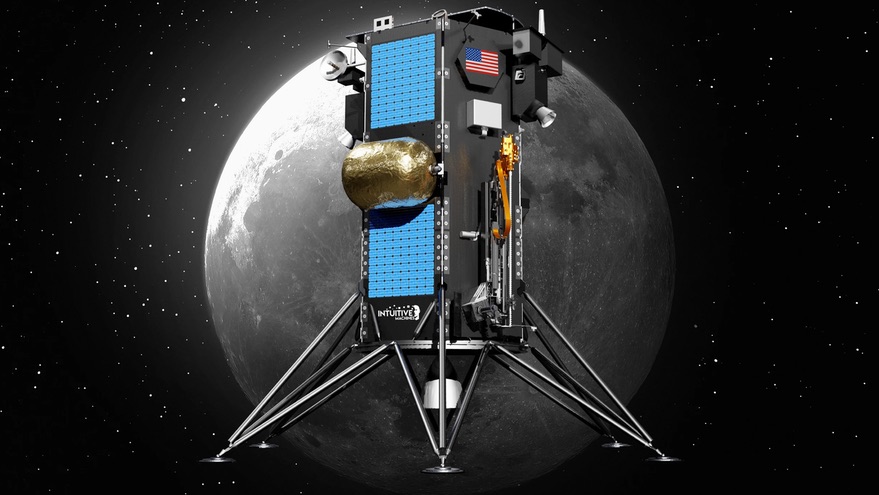WASHINGTON — NASA has awarded more than $400 million in contracts to both demonstrate technologies needed for future lunar exploration and to send an ice-drilling payload to the south pole of the moon.
NASA announced Oct. 16 that it awarded a task order worth $47 million to Intuitive Machines, one of 14 companies in the Commercial Lunar Payload Services (CLPS) program, to deliver the Polar Resources Ice Mining Experiment 1 (PRIME-1) payload to the south pole of the moon by the end of 2022.
PRIME-1 is a 40-kilogram payload designed to look for water ice at depths of up to one meter below the lunar surface. It will test a near-infrared spectrometer, mass spectrometer and drill that NASA plans to fly on the Volatiles Investigating Polar Exploration Rover (VIPER) mission in 2023.
“We’re building up our capabilities for in-situ resource utilization, utilizing the resources on the moon,” Jim Reuter, NASA associate administrator for space technology, said at an Oct. 14 meeting of the Lunar Surface Innovation Consortium, a group that brings together academia, government and industry to assess technologies needed for exploration of the lunar surface. PRIME-1, he said, was one of the first experiments to support that effort.
NASA Administrator Jim Bridenstine, speaking earlier at the same meeting, also discussed the importance of both PRIME-1 and VIPER. “These missions are critically important to help us understand where we need to go so we can get the best assessment of those volatiles,” he said, which can help the agency identify promising landing site for future crewed Artemis missions.
This mission will be the second for Intuitive Machines under the CLPS program. It received in May 2019 one of the first CLPS task orders, for a mission scheduled for launch in late 2021. Astrobotic also received one of those first task orders, as well as one in June for the VIPER mission. Masten Space Systems won a CLPS order in April for a mission to the south polar regions of the moon.
The announcement of the PRIME-1 launch came two days after NASA awarded a much larger amount of money for lunar surface technologies. The 15 awards to 14 companies, made through the agency’s Tipping Point program, are intended to advance technologies nearing maturity that could support the later, “sustainable,” phase of the Artemis program.
“NASA believes that these kinds of companies, and capabilities they’ve developed, are going to be transformational for how we explore space,” Bridenstine said at the consortium meeting, where he announced the Tipping Point awards. “But we also believe it’s going to take a little bit of a push from NASA.”
Of the $372.2 million in Tipping Point contracts, $256.1 million will go to four companies working on cryogenic fluid management technology demonstrations: Eta Space, Lockheed Martin, SpaceX and United Launch Alliance. All four companies plan to conduct in-space demonstrations of technologies for storage and transfer of propellants like liquid hydrogen and liquid oxygen.
“When we fly into space, we have to story cryogenic fluids for long periods of time,” Bridenstine said. “How can we manage cryogenic fluids so we can do spaceflight in ways that we wouldn’t otherwise be able to?”
Eta Space will use its $27 million award to fly a small satellite called LOXSAT 1 to test liquid oxygen storage technologies. Eta Space is working with Rocket Lab, which will provide the Photon satellite bus LOXSAT 1 is based on and launch the spacecraft on its Electron rocket.
Lockheed Martin won an $89.7 million award to test liquid hydrogen storage technologies on a small satellite. The company is working with Momentus, which will host the payload on a Vigoride orbital transfer vehicle, and Relativity Space, which will launch the vehicle on its Terran 1 rocket in October 2023.
SpaceX, which has already been working with NASA on studying cryogenic fluid management technologies, won $53.2 million to demonstrate the transfer of 10 tons of liquid oxygen between tanks on a Starship vehicle in orbit. SpaceX Chief Executive Elon Musk, asked about orbital refueling at a Mars Society conference Oct. 16, said “we’ve got a shot of doing that in ’22.”
United Launch Alliance will use its $86.2 million award to demonstrate a “smart propulsion cryogenic system” using the Centaur upper stage of its new Vulcan rocket. That demonstration includes testing tank-to-tank transfer of propellants and “multi-week” storage.
The remaining Tipping Point funding went to 10 companies to demonstrate a range of technologies needed for landing and operating on the lunar surface. Masten Space Systems won two contracts, with a total value of $12.8 million, to demonstrate precision landing technologies with its Xogdor vehicle and a system to provide heat and power for payloads to allow them to survive the lunar night.
Other awards, ranging in value from $2.4 million to $41.6 million, cover technologies such as power systems, a payload to extract oxygen from lunar regolith, and a robotic arm. Nokia won a $14.1 million award to develop lunar communications systems using 4G wireless networks.
Intuitive Machines won the largest of those awards for development of a “hopper” that can carry a one-kilogram payload up to 2.5 kilometers across the lunar surface. “That’s going to give us high-resolution mapping of maybe volatiles on the surface of the moon,” Bridenstine said. “It’s going to help us understand how to pinpoint very precise landing spots on the surface of the moon.”
